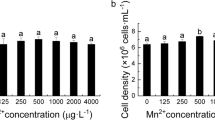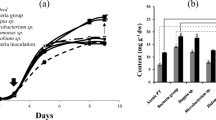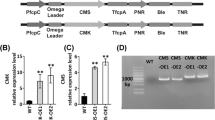Abstract
There are a large number of valuable substances in diatoms, such as neutral lipid and pigments. However, due to the lack of clear metabolic pathways, their applications are still limited. Recently, chemical modulators are found to be powerful tools to investigate the metabolic pathways of neutral lipids. Thus, in this study, to identify new neutral lipid accumulation effectors, we screened the natural products that we separated before in the model diatom Phaeodactylum tricornutum (P. tricornutum) by using Nile-red staining method. Two compounds, penicillide and verrucarin J which were isolated from two marine fungal strains, were identified to promote neutral lipid accumulation. However, penicillide and verrucarin J were also found to significantly inhibit the growth of P. tricornutum through specifically inhibiting the photosynthesis of P. tricornutum. Quantitative analysis results showed that penicillide and verrucarin J significantly increased total lipid and triacylglycerol (TAG) contents, which are consistent with previous Nile-red staining results. The expression of key genes such as DGAT2D, GPAT2, LPAT2, and PAP involved in TAG synthesis and unsaturated fatty acids also increased after penicillide and verrucarin J treatments. Besides, many TAG-rich plastoglobuli formed in plastids shown by increased lipid droplets in the cytosol. Finally, penicillide and verrucarin J were found to reduce the expression of synthetic genes of fucoxanthin, and consequently reduced the content of fucoxanthin, indicating that there might be crosstalk between lipid metabolism and fucoxanthin metabolism. Thus, our work exhibits two useful compounds that could be used to further study the metabolic pathways of neutral lipid and fucoxanthin, which will fulfill the promise of diatoms as low cost, high value, sustainable feedstock for high-value products such as neutral lipid and pigments.








Similar content being viewed by others
References
Abida H, Dolch LJ, Mei C, Villanova V, Conte M, Block MA, Finazzi G, Bastien O, Tirichine L, Bowler C, Rébeillé F (2015) Membrane glycerolipid remodeling triggered by nitrogen and phosphorus starvation in Phaeodactylum tricornutum. Plant Physiol 167:118–136
Alipanah L, Rohloff J, Winge P, Bones AM, Brembu T (2015) Whole-cell response to nitrogen deprivation in the diatom Phaeodactylum tricornutum. J Exp Bot 66:6281–6296
Amagata T, Rath C, Rigot JF, Tarlov N, Tenney K, Valeriote FA, Crews P (2003) Structures and cytotoxic properties of Trichoverroids and their macrolide analogues produced by saltwater culture of Myrothecium verrucaria. J Med Chem 46:4342–4350
Bai X, Song H, Lavoie M, Zhu K, Su Y, Ye H, Chen S, Fu Z, Qian H (2016) Proteomic analyses bring new insights into the effect of a dark stress on lipid biosynthesis in Phaeodactylum tricornutum. Sci Rep 6:25494
Beaugrand G, Luczak C, Goberville E, Kirby RR (2018) Marine biodiversity and the chessboard of life. PLoS One 13:e0194006
Braig S (2018) Chemical genetics in tumor lipogenesis. Biotechnol Adv 36:1724–1729
Carroll AR, Copp BR, Davis RA, Keyzers RA, Prinsep MR (2019) Marine natural products. Nat Prod Rep
Cermeño P, Falkowski PG, Romero OE, Schaller MF, Vallina SM (2015) Continental erosion and the Cenozoic rise of marine diatoms. Proc Natl Acad Sci USA 112:4239–4244
Chandrasekaran B, Tyagi A, Sharma AK, Cai L, Ankem M, Damodaran C (2017) Molecular insights: suppression of EGFR and AKT activation by a small molecule in non-small cell lung cancer. Genes Cancer 8:713
Chemodanov A, Robin A, Golberg A (2017) Design of marine macroalgae photobioreactor integrated into building to support seagriculture for biorefinery and bioeconomy. Bioresour Technol 241:1084–1093
Chen RY, Xu RJ, Gong YF, Liu F, Fu X, Zhang L, Wang HY, Shi H (2019) Effects of nitrogen on the expression and metabolic synthesis of key enzymes in fucoxanthin and oil synthesis of Phaeodactylum tricornutum. J Nucl Agric 33:1734–1741 (In Chinese)
Conte M, Lupette J, Seddiki K, Meï C, Dolch LJ, Gros V, Barette C, Rébeillé F, Jouhet J, Marechal E (2018) Screening for biologically annotated drugs that trigger triacylglycerol accumulation in the diatom Phaeodactylum. Plant Physiol 177:532–552
d’Ippolito G, Sardo A, Paris D, Vella FM, Adelfi MG, Botte P, Gallo C, Fontana A (2015) Potential of lipid metabolism in marine diatoms for biofuel production. Biotechnol Biofuels 8:28
De Rybel B, Audenaert D, Vert G, Rozhon W, Mayerhofer J, Peelman F, Coutuer S, Denayer T, Jansen L, Nguyen L, Vanhoutte I (2009) Chemical inhibition of a subset of Arabidopsis thaliana GSK3-like kinases activates brassinosteroid signaling. Chem Biol 16:594–604
Dejonghe W, Russinova E (2017) Plant chemical genetics: from phenotype-based screens to synthetic biology. Plant Physiol 174:5–20
Eilers U, Bikoulis A, Breitenbach J, Büchel C, Sandmann G (2016) Limitations in the biosynthesis of fucoxanthin as targets for genetic engineering in Phaeodactylum tricornutum. J Appl Phycol 28:123–129
Fang F, Zhao J, Ding L, Huang C, Naman CB, He S, Wu B, Zhu P, Luo Q, Gerwick WH, Yan X (2017) 5-Hydroxycyclopenicillone, a new β-amyloid fibrillization inhibitor from a sponge-derived fungus Trichoderma sp. HPQJ-34. Mar Drugs 15:260
Gu B, Zhang Y, Ding L, He S, Wu B, Dong J, Zhu P, Chen J, Zhang J, Yan X (2015) Preparative separation of sulfur-containing diketopiperazines from marine fungus Cladosporium sp. using high-speed counter-current chromatography in stepwise elution mode. Mar Drugs 13:354–365
Kim SM, Jung YJ, Kwon ON, Cha KH, Um BH, Chung D, Pan CH (2012) A potential commercial source of fucoxanthin extracted from the microalga Phaeodactylum tricornutum. Appl Biochem Biotechnol 166:1843–1855
Komarov PG, Komarova EA, Kondratov RV, Christov-Tselkov K, Coon JS, Chernov MV, Gudkov AV (1999) A chemical inhibitor of p53 that protects mice from the side effects of cancer therapy. Science 285:1733–1737
Kromkamp J, Barranguet C, Peene J (1998) Determination of microphytobenthos PSII quantum efficiency and photosynthetic activity by means of variable chlorophyll fluorescence. Mar Ecol Prog Ser 162:45–55
Li X, Yang R, Chen H (2018a) The Arabidopsis thaliana Mediator subunit MED8 regulates plant immunity to Botrytis Cinerea through interacting with the basic helix-loop-helix (bHLH) transcription factor FAMA. PLoS One 13:e0193458
Li X, Yang R, Gong Y, Chen H (2018b) The Arabidopsis mediator complex subunit MED19a is involved in ABI5-mediated ABA responses. J Plant Biol 61:97–110
Li-Beisson Y, Thelen JJ, Fedosejevs E, Harwood JL (2019) The lipid biochemistry of eukaryotic algae. Prog Lipid Res
Liu C, Zou D (2015) Responses of elevated CO2 on photosynthesis and nitrogen metabolism in Ulva lactuca (Chlorophyta) at different temperature levels. Mar Biol Res 11:1043–1052
Liu Y, Zhou X, Naman CB, Lu Y, Ding L, He S (2018) Preparative separation and purification of trichothecene mycotoxins from the marine fungus Fusarium sp. LS68 by high-speed countercurrent chromatography in stepwise elution mode. Mar Drugs 16:73
Liu Y, Ding L, Fang F, He S (2019) Penicillilactone a, a novel antibacterial 7-membered lactone derivative from the sponge-associated fungus Penicillium sp. LS54. Nat Prod Res 33:2466–2470
Livak KJ, Schmittgen TD (2001) Analysis of relative gene expression data using real-time quantitative PCR and the 2-ΔΔCT method. Methods 25:402–408
Malve H (2016) Exploring the ocean for new drug developments: marine pharmacology. J Pharm Bioallied Sci 8:83
Mansour MP, Volkman JK, Jackson AE, Blackburn SI (1999) The fatty acid and sterol composition of five marine dinoflagellates. J Phycol 35:710–720
Munekage Y, Hashimoto M, Miyake C, Tomizawa KI, Endo T, Tasaka M, Shikanai T (2004) Cyclic electron flow around photosystem I is essential for photosynthesis. Nature 429:579
Natunen K, Seppälä J, Koivula RJ, Pellinen J (2017) Monitoring cell-specific neutral lipid accumulation in Phaeodactylum tricornutum (Bacillariophyceae) with Nile red staining–a new method for flow CAM. J Phycol 53:396–404
Nur MM, Muizelaar W, Boelen P, Buma AG (2019) Environmental and nutrient conditions influence fucoxanthin productivity of the marine diatom Phaeodactylum tricornutum grown on palm oil mill effluent. J Appl Phycol 31:111–122
Pal D, Tyagi A, Chandrasekaran B, Alattasi H, Ankem MK, Sharma AK, Damodaran C (2018) Suppression of Notch1 and AKT mediated epithelial to mesenchymal transition by Verrucarin J in metastatic colon cancer. Cell Death Dis 9:798
Park SY, Fung P, Nishimura N, Jensen DR, Fujii H, Zhao Y, Lumba S, Santiago J, Rodrigues A, Tsz-fung FC, Alfred SE (2009) Abscisic acid inhibits type 2C protein phosphatases via the PYR/PYL family of START proteins. Science 324:1068–1071
Qian PY, Li Z, Xu Y, Li Y, Fusetani N (2015) Mini-review: marine natural products and their synthetic analogs as antifouling compounds: 2009–2014. Biofouling 31:101–122
Rumin J, Bonnefond H, Saint-Jean B, Rouxel C, Sciandra A, Bernard O, Cadoret JP, Bougaran G (2015) The use of fluorescent Nile red and BODIPY for lipid measurement in microalgae. Biotechnol Biofuels 8:42
Ryan PR, Liu Q, Sperling P, Dong B, Franke S, Delhaize E (2007) A higher plant Δ8 sphingolipid desaturase with a preference for (Z)-isomer formation confers aluminum tolerance to yeast and plants. Plant Physiol 144:1968–1977
Sassa T, Niwa G, Unno H, Ikeda M, Miura Y (1974) Structure of Penicillide, a new metabolite produced by a Penicillium sp. Tetrahedron Lett
Sebolt-Leopold JS, Dudley DT, Herrera R, Van Becelaere K, Wiland A, Gowan RC, Tecle H, Barrett SD, Bridges A, Przybranowski S, Leopold WR (1999) Blockade of the MAP kinase pathway suppresses growth of colon tumors in vivo. Nat Med 5:810
Tall AR (1993) Plasma cholesteryl ester transfer protein. J Lipid Res 34:1255–1274
Tsuchiya Y, Vidaurre D, Toh S, Hanada A, Nambara E, Kamiya Y, Yamaguchi S, McCourt P (2010) A small-molecule screen identifies new functions for the plant hormone strigolactone. Nat Chem Biol 6:741
Tsuji Y, Nakajima K, Matsuda Y (2017) Molecular aspects of the biophysical CO2-concentrating mechanism and its regulation in marine diatoms. J Exp Bot 68:3763–3772
Vaidya AS, Helander JD, Peterson FC, Elzinga D, Dejonghe W, Kaundal A, Park SY, Xing Z, Mega R, Takeuchi J, Khanderahoo B (2019) Dynamic control of plant water use using designed ABA receptor agonists. Science 366:eaaw8848
Valenzuela JJ, de Lomana AL, Lee A, Armbrust EV, Orellana MV, Baliga NS (2018) Ocean acidification conditions increase resilience of marine diatoms. Nat Commun 9:2328
Wase N, Tu B, Allen JW, Black PN, DiRusso CC (2017) Identification and metabolite profiling of chemical activators of lipid accumulation in green algae. Plant Physiol 174:2146–65
Wase N, Black P, DiRusso C (2018) Innovations in improving lipid production: algal chemical genetics. Prog Lipid Res 71:101–123
Watson SA, Allan BJ, McQueen DE, Nicol S, Parsons DM, Pether SM, Pope S, Setiawan AN, Smith N, Wilson C, Munday PL (2018) Ocean warming has a greater effect than acidification on the early life history development and swimming performance of a large circumglobal pelagic fish. Glob Chang Biol 24:4368–4385
Xu J, Fan X, Li X, Liu G, Zhang Z, Zhu Y, Fu Z, Qian H (2017) Effect of salicylic acid on fatty acid accumulation in Phaeodactylum tricornutum during stationary growth phase. J Appl Phycol 29:2801–2810
Xue J, Niu YF, Huang T, Yang WD, Liu JS, Li HY (2015) Genetic improvement of the microalga Phaeodactylum tricornutum for boosting neutral lipid accumulation. Metab Eng 27:1–9
Yan X, Chuda Y, Suzuki M, Nagata T (1999) Fucoxanthin as the major antioxidant in Hijikia fusiformis, a common edible seaweed. Biosci Biotechnol Biochem 63:605–607
Yang ZK, Niu YF, Ma YH, Xue J, Zhang MH, Yang WD, Liu JS, Lu SH, Guan Y, Li HY (2013) Molecular and cellular mechanisms of neutral lipid accumulation in diatom following nitrogen deprivation. Biotechnol Biofuels 6:67
Zhang Q, Deng C, Fang L, Xu W, Zhao Q, Zhang J, Wang Y, Lei X (2013) Synthesis and evaluation of the analogues of penicillide against cholesterol ester transfer protein. Chinese J Chem 31:355–370
Zhao Y, Chow TF, Puckrin RS, Alfred SE, Korir AK, Larive CK, Cutler SR (2007) Chemical genetic interrogation of natural variation uncovers a molecule that is glycoactivated. Nat Chem Biol 3:716
Funding
The work was financially supported by the National Natural Science Foundation of China (Grant No. 31600986), and the K.C. Wong Magna Fund in Ningbo University.
Author information
Authors and Affiliations
Corresponding author
Ethics declarations
Conflict of interest
The authors declare that they have no conflict of interest.
Ethical statement
This article does not contain any studies with human participants or animals performed by any of the authors.
Additional information
Publisher’s note
Springer Nature remains neutral with regard to jurisdictional claims in published maps and institutional affiliations.
Electronic supplementary material
ESM1
(PDF 425 kb)
Rights and permissions
About this article
Cite this article
Yu, M., Chen, X., Jiang, M. et al. Two marine natural products, penicillide and verrucarin J, are identified from a chemical genetic screen for neutral lipid accumulation effectors in Phaeodactylum tricornutum. Appl Microbiol Biotechnol 104, 2731–2743 (2020). https://doi.org/10.1007/s00253-020-10411-7
Received:
Revised:
Accepted:
Published:
Issue Date:
DOI: https://doi.org/10.1007/s00253-020-10411-7




